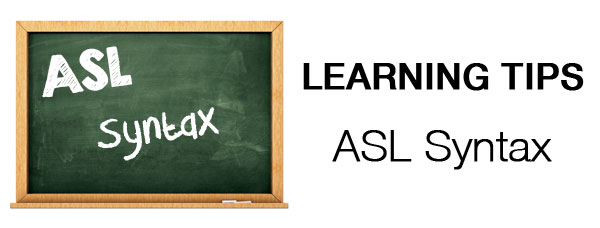
ASL Syntax
In addition to having its own vocabulary, American Sign Language also has its own grammar and syntax that differs from English.
Just like English, every ASL sentence consists of a subject and a predicate.
Signing (and Grammatical) Terminology
Subject - The noun or noun phrases in the sentence. Describes the main focus of the sentence - the person, place, thing, idea, or activity.
Predicate - A predicate can be a verb, a noun, an adjective, or a classifier. The predicate contains the words or signs that describe the action performed by the subject or that say something about the subject.
The basic, uninflected, word order of ASL is subject, verb, object.
The basic, uninflected, word order of ASL is subject, verb, object.
For example:
- BOY CHASE CAT
- I LOSE MY BOOK
Signing (and Grammatical) Terminology
Uninflected - Uses basic grammatical structure without any changes so that is does not express grammatical functions or attributes.
There are many ways to inflect the meaning of sentences.
There are many ways in which a person may inflect their sentences. For example, in English a person may say "The boy chased the cat" or "The cat was chased by the boy". The second example is of an inflected sentence using the "passive voice" rule. Both of the sentences are correct, they just represent different ways of communicating the information.
In the same way, an ASL user may use topicalization or a rhetorical construction to inflect an ASL statement.
For example:
- BOY CHASE CAT (uninflected)
- CAT BOY CHASE (topicalized)
There is a required non-manual signal in inflected ASL sentences.
Signing (and Grammatical) Terminology
Inflect / Inflection - Inflection is done to emphasize a word or subject or to indicate a grammatical attribute such as tense, mood, person, number, case, or gender.
Passive voice - The passive voice is used when the action is not being done by the noun.
Topicalize / Topicalization - Topicalization causes a subject, word, or phrase to be the topic of a sentence. Often, the subject/object is stated first when topicalizing.
Rhetorical construction - Constructing signs to effectively deliver a message.
Non-manual signals - Non-manual signals are facial expressions or body positions used to convey meaning while you sign.
There are three types of ASL verbs.
- PLAIN verbs are always signed the same, no matter who is performing the action
- INDICATING verbs (sometimes called "directional" verbs) change based on either the subject doing the action, or where the action is taking place
- DEPICTING verbs (sometimes called "classifiers") show what things look like, where they are in space, or how things behave
Unlike in English, all verbs in ASL must always be directly preceded by the subject (ie, who is doing the action). Some examples are listed below. In all of the examples, the subject and verb are connected and cannot have signs appear between them - this is signified by a line between the subject and verb (_).
- The verb LOVE is a "plain" verb.
English: "I love books."
ASL: I _ LOVE BOOK (uninflected)
ASL: BOOK I _ LOVE (topicalized)
- The verb HELP is an "indicating" or "directional" verb.
English: "I am helping my sister."
ASL: ASL: I _ HELP MY SISTER (uninflected)
ASL: MY SISTER I _ HELP (topicalized)
- The verb CL:3 is "depicting" or a "classifier"
English: "The car is next to the man."
ASL: CAR _ CL:3 (in space) MAN _ CL:1 (in space)
Notice, in all of the above sentences, the subject (the person doing the action) always directly precedes the verb. The following sentences would be unintelligible in ASL:
- BOOK LOVE I
- HELP MY SISTER I
- CL:3 CAR
ASL syntax is a complex topic and it takes knowledge and practice to master. Did this article help? Still have questions? Post a comment below.
ADVERTISEMENTS
 ASL glossing and conventions
ASL glossing and conventions Signs That Are Close... But Not the Same - Set 8
Signs That Are Close... But Not the Same - Set 8 Living Loud: Phyllis Frelich - Actress, Innovator, and Tony Award Winner
Living Loud: Phyllis Frelich - Actress, Innovator, and Tony Award Winner







Savvy User jenniferFriday, May 23, 2014
I love this new idea of learning posts. I am an ITP grad and love the review of this info and it refreshes my memory. Keep them coming! Very informative! :)